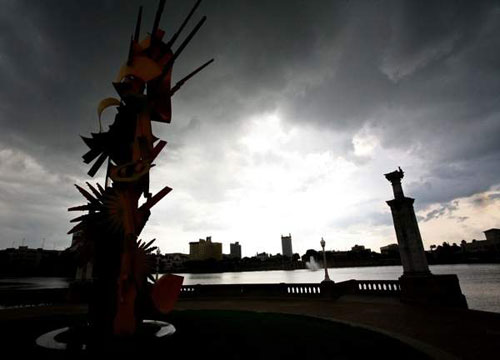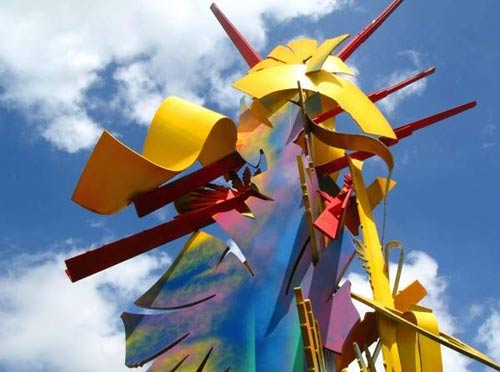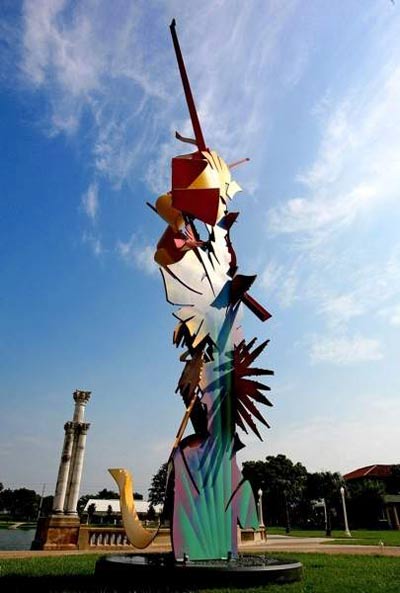
 Sculpture News at SculptSite.com
Sculpture News at SculptSite.com
Albert Paley "The Spirit of Volunteerism" Sculpture on Lake Mirror |
| The Ledger By Gary White LAKELAND, FLORIDA -- If anyone personifies the spirit of the volunteer, it might be Amabel Traylor, an unpaid engine of civic boosterism. Before moving to Lakeland 12 years ago, Traylor was, in her words, a "professional volunteer" in Ohio. These days, she is a familiar presence in downtown Lakeland, rolling from one landmark to the next in her powered wheelchair, accompanied by a border collie named Rascal. Traylor, 66, seizes every opportunity to lead visitors on tours of the city. Traylor's jaunts often take her past a colorful and heroically scaled sculpture on Lake Mirror's eastern shore, a piece of public art called "Tribute to the Spirit of Volunteerism." The sculpture consists of a purplish, central column buttressed by a tilted yellow spear and fan-like bursts and topped by curling, golden ribbons offset by five bright red spikes surging upward at contrasting angles. When sculptor Albert Paley's crew installed the 41-foot-tall, 18,000-pound metal assemblage in April 2004, Traylor was among those who wondered whether the abstract design really reflected volunteer ventures. Six years later, Traylor said she has developed a fondness for the sculpture. "I still question that (symbolism), but I have come to enjoy it," Traylor said. "It always gives me a smile. That's the thing about it; it has come to give me a smile because I don't understand what it's supposed to be but I enjoy it." The sculpture, the largest and most expensive piece of public art in Polk County, provoked wildly divergent reactions when it was dedicated in 2004. Though it may no longer be a subject of much public discussion, the piece still elicits opinions ranging from dismissal to admiration. "There are people who love it and always have loved it, and there are people who have always hated it and you've got some - it will grow on them," said David Bunch, who co-chaired the committee that commissioned the sculpture. COMPLETING THE PLAN Landscape architect Charles Leavitt's 1926 design for the area around Lake Mirror included a monument on the eastern shore, but the city shelved that and other design elements amid an economic collapse. Seven decades later, Lakeland officials decided it was time to fulfill Leavitt's original scheme and hired an urban planning firm to come up with a design plan, which included a traditional obelisk. Planners eventually abandoned the obelisk idea in favor of something more modern. A coalition led by Historic Lakeland, a nonprofit group, raised $100,000 in private money and solicited designs from artists across the country. A committee that included city officials, art authorities and regular citizens, chose Paley's entry over some 160 other candidates. The sculpture's champions said its dynamic collage of shapes and melange of hues symbolized the exuberance and diversity of Lakeland's volunteers. Others reacted with less enthusiasm. Alice O'Reilly, executive director of Volunteers in Service to the Elderly and a member of the selection committee, didn't like the choice. Her opinion hasn't changed in six years. "I have not grown accustomed to it yet," O'Reilly said recently. "To me, it doesn't symbolize volunteerism, and when I look at it I don't think, 'Oh, Lakeland is such a wonderful community for its volunteerism' - which is true. It really doesn't bother me. I just wanted something more symbolic that was readily recognized (as a) salute to volunteerism." Others complained that the modernist work clashed with its surroundings. The promenade around Lake Mirror strikes a classical mode, with its stone balustrade and graceful, evenly spaced lampposts. The Rev. Riley Short, a retired minister at Lakeland's First United Methodist Church, remains unimpressed with the sculpture. "That piece does not say anything to me, and it is a very modern piece in the midst of neo-Greek architecture," Short said. "One person said I needed to be told what it stood for. In my opinion, art should speak for itself and this piece does not say anything to me, much less anything about volunteerism." Short added, "I do not have a problem with it. I just ignore it." CRITICISM IS COMMON Paley, who lives in Rochester, N.Y., has said he appreciates all forceful reactions to his work, even negative ones. Some of his massive public sculptures in other cities have drawn ridicule and derisive nicknames. "Hallelujah," a twisty, mustard-and-chrome collage, went up last year in front of The Clay Center for the Arts and Sciences in Charleston, W.Va. The local newspaper ran an online survey, and opinions were evenly split on the sculpture, with one respondent trashing the work as "an ill-fitting assortment of scrap metal." "Zenith," a piece rather similar to the Lakeland sculpture, adorns the entrance to a train station that opened in 2008 in Trenton, N.J. A writer for the local paper savaged it in a column headlined, "I'm the beholder, and this art stinks." In the art world, though, Paley, 66, seems to generate nearly unanimous praise. He was the first sculptor to receive the Lifetime Achievement Award from the American Institute of Architects. The Metropolitan Museum in New York is one of many that own sculptures by Paley. In 2012, the Corcoran Gallery in Washington, D.C., plans to exhibit a 50-year retrospective of his work, after which the display will go to the Victoria and Albert Museum in London. Several books have been written about Paley. Lorry Dudley, an independent art curator based in Maryland, said Paley ranks in the top tier of living sculptors. "I personally feel there's never been an artist who has done so many major works all over the world ... that require the amount of skill, technical virtuosity, manipulating material to its furthest extent and multiple materials," Dudley said. Daniel Stetson, executive director of the Polk Museum of Art, co-chaired the selection committee, along with Bunch, who represents Historic Lakeland, a nonprofit group. Stetson said he thinks the community has come to accept the sculpture. "I actually don't hear negative comments anymore," Stetson said. "I do hear questions from visitors about how we got it and where did it come from. Some are amazed that we have it, as if a smaller city shouldn't have such a nationally important work of this scale." Bunch, a commercial real-estate agent, said the original idea of an obelisk would have been a safe choice but wouldn't carry the same appeal for "the next generation" as Paley's bolder piece. Bunch said the sculpture, with its diverse colors and its celebratory shapes, abounds in symbolism honoring to the volunteer spirit. "I used to go down there - and I still do on occasion - and see someone standing there or walking past it, and I'll introduce myself and say, 'What does it mean to you?'" Bunch said. "I'll take a moment to explain Paley's theory ... and it changes them on the spot." As for complaints that the sculpture clashes with its surroundings, Bunch said the perimeter of Lake Mirror already offered a hodgepodge of artistic styles before Paley's piece joined the mix. |
 Albert Paley's sculpture "The Spirit of Volunteerism" on Lake Mirror still captures wandering eyes even after its initial installation 6 years ago. Tuesday July 20, 2010 |
 |
SHOWCASING A MONUMENT Though no public funds were spent on the sculpture itself, the city has since made changes on the eastern side of Lake Mirror that give the piece a better presentation. The city rerouted the road around the lake, creating a sloping lawn leading down to the sculpture, which occupies a circular grassy spot ringed by a walkway. More than $20 million in public and private money has been spent to complete the Lake Mirror master plan, said Bill Tinsley, Lakeland's director of parks and recreation. Tinsley said the Paley sculpture has benefited from the beautification project. "From my way of thinking, it's received much more warmly by people now because of its setting," Tinsley said. "It's certainly a highly photographed thing. It's become a very accepted part of the landscape at Lake Mirror. Whereas earlier it was probably 50-50, now there are very few criticisms of the piece." Tinsley said the city has performed regular maintenance on the sculpture, pressure-washing it as needed and replacing ground-level lights that illuminate the piece at night. He said the sculpture's colors have endured the sun exposure well, and the piece probably won't need repainting any time soon. While Bunch is happy to offer his interpretation of the sculpture to anyone he happens to encounter, he is not a full-time presence at Lake Mirror. At least four years ago, Bunch suggested placing an explanatory sign near the statue, but to this point the city has not done so. Tinsley said the city is not opposed to a sign, but he said it would have to be paid for with private funds and would need to be consistent with existing signs around Lake Mirror. Even without such a visual clue, Traylor has come to appreciate the sculpture on her own terms. "Whether it goes (with its surroundings) or whether it doesn't, I love the colors," Traylor said. "When I was young, I was taught, 'onward and upward,' and to me that's personally one of the things it has come to represent. It certainly has an upward flow." Traylor, who said she is "still developing" at age 66, suggested the 6-year-old sculpture may yet continue to evolve in the minds of beholders for a long time. |
 I seem to think that Amabel Traylor has got it right. Sculpture can and will grow on you. Yes, there is that thing called time again, which I've always thought that time was an important component of sculpture. The City of Lakeland is so fortunate to have an Albert Paley sculpture - I know it makes it a better place to live and visit. I'm looking forward to the 50 year retrospective of Albert Paley's work at Corcoran Gallery. That is a definite in my travel plans for 2012. I would to also thank Gary White for a very insightful read, nicely crafted! |
 |
More Sculpture News ....
Submit your SCULPTURE NEWS.
It's easy, just send us an e-mail
(click on Submit News in the left menu) with your pertinent information along with images, we'll take care of the rest. Sculpture makes our world a much better place in so many ways!
SculptSite.com, along with Sculptors and their creative genius all helping to bring the beauty and message of Sculpture to a hurried world.

